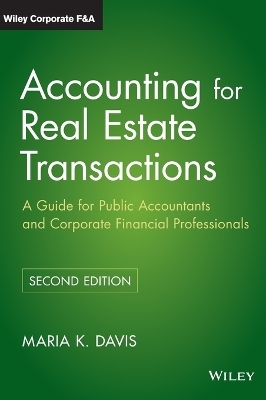
Accounting for Real Estate Transactions
John Wiley & Sons Inc (Verlag)
978-0-470-60338-3 (ISBN)
- Lieferbar (Termin unbekannt)
- Versandkostenfrei innerhalb Deutschlands
- Auch auf Rechnung
- Verfügbarkeit in der Filiale vor Ort prüfen
- Artikel merken
Maria Davis, CPA, Partner, Accounting Consultation Group, Deloitte, National Office, is a frequent speaker on real estate technical updates and contributor to AICPA Statement of Position, Accounting for Real Estate Time-Sharing Transactions, and AICPA Statement of Position, Accounting for Certain Costs and Activities Related to Property, Plant, and Equipment. She provides accounting guidance on technical accounting issues, primarily in the subject matters of Real Estate and Leases and joint Ventures and Consolidation, both under U.S. GAAP and IFRS. In addition to more than thirty real estate technical updates across the U.S., she has developed training materials covering accounting and real estate transactions. Over the course of her career with Deloitte, Ms. Davis has provided attest and advisory services to Deloitte's clients in a variety of industries in both the United States and Europe.
Preface xiii
About the Author xv
List of Abbreviations xvii
Part 1 Accounting for Real Estate Transactions—General 1
Chapter 1: Acquisition, Development, and Construction of Real Estate 3
1.1. Overview 3
1.2. Acquisition, Development, and Construction Costs 4
1.2.1. Preacquisition Costs 4
1.2.2. Project Costs 8
1.2.3. Cost Allocation 15
1.2.4. Change in Estimates or Project Plans and Abandonments of Projects 18
1.3. Costs Incurred to Sell or Rent a Real Estate Project 20
1.3.1. Costs Incurred to Sell a Real Estate Project 20
1.3.2. Costs Incurred to Rent a Real Estate Project 23
1.4. Incidental Operations 24
1.5. Accounting for Costs Incurred Subsequent to Project Completion 24
1.5.1. Determining the Date of Project Completion 24
1.5.2. Costs Incurred Subsequent to Project Completion 25
1.6. Purchase of Income-Producing Property 26
1.6.1. Purchase of a Business 26
1.6.2. Purchase of an Asset/Asset Group 28
1.6.3. Recognition of Intangible Assets Acquired 29
1.6.4. Measurement of Property, Plant, Equipment, and Intangibles 30
1.6.5. Allocation of Acquisition Cost 33
1.6.6. Accounting for Intangibles Subsequent to Acquisition 36
1.6.7. Key Differences: Business versus Asset Acquisitions 37
1.7. Special Accounting Issues 38
1.7.1. Costs of Amenities 38
1.7.2. Start-up Costs 39
1.7.3. Land Options 41
1.7.4. Financing as Part of a Purchase Transaction 45
1.7.5. Environmental Costs and Liabilities 46
1.7.6. Transactions with Related Parties 54
1.8. Financial Statement Presentation and Disclosure 57
1.8.1. Cash Flow Statement Presentation 57
1.8.2. Segment Disclosures for Public Companies 57
1.8.3. Other Presentation and Disclosure Requirements 58
1.9. International Financial Reporting Standards 60
1.9.1. IAS 16, Property, Plant and Equipment 60
1.9.2. IAS 40, Investment Property 64
1.9.3. IFRS 3, Business Combinations 69
1.10. Synopsis of Authoritative Literature (Pre-Codification References) 72
Chapter 2: Nonmonetary Exchanges of Real Estate 83
2.1. Overview 83
2.2. Section 1031 Exchange 84
2.3. Nonmonetary Exchanges Not Governed by Topic 845 (APB Opinion No. 29) 88
2.3.1. Exchange with Continuing Involvement of the Transferor 89
2.3.2. In-Substance Sale and Purchase Transaction 90
2.3.3. Nonmonetary Exchange Involving Business 90
2.3.4. Involuntary Conversion 91
2.4. Accounting for Nonmonetary Exchanges 91
2.4.1. General Principle—Fair Value 91
2.4.2. Exceptions to the Fair Value Principle 92
2.5. Nonmonetary Exchange of Real Estate Involving Monetary Consideration 94
2.5.1. Accounting by Receiver of Monetary Consideration 94
2.5.2. Accounting by Payer of Monetary Consideration 96
2.6. Special Accounting Issues 97
2.6.1. Exchange-Leaseback 97
2.6.2. Transactions between Related Parties 97
2.7. Financial Statement Presentation and Disclosure 99
2.8. International Financial Reporting Standards 100
2.8.1. Commercial Substance of Exchange Transaction 101
2.8.2. Fair Value Measurement 101
2.9. Synopsis of Authoritative Literature (Pre-Codification References) 101
Chapter 3: Real Estate Sales 107
3.1. Overview 107
3.2. Applicability of the Real Estate Sale Guidance 110
3.3. Sale and Profit Recognition 112
3.3.1. Sale of Real Estate with Long Construction Periods 112
3.4. Profit Recognition under the Accrual Method 113
3.4.1. General Rule 113
3.4.2. Specific Criteria 114
3.5. Failure to Meet Criteria for the Application of the Accrual Method 123
3.5.1. Inadequate Initial Investment 124
3.5.2. Inadequate Continuing Investment 125
3.5.3. Receivable Subject to Future Subordination 125
3.5.4. Continuing Involvement 125
3.6. Application of Other Accounting Methods 142
3.6.1. Deposit Method 142
3.6.2. Installment Method 146
3.6.3. Cost Recovery Method 148
3.6.4. Reduced Profit Method 150
3.6.5. Percentage-of-Completion Method 150
3.6.6. Financing Method 152
3.6.7. Leasing Method 154
3.6.8. Profit-Sharing Method 155
3.6.9. Performance-of-Services Method 156
3.7. Special Accounting Issues 158
3.7.1. Impairment and Loss on Sale 158
3.7.2. Extinguishment of Debt with the Sale of Property 165
3.7.3. Wrap-around Mortgage 166
3.7.4. Effect of Nonrecourse Financing on Profit Recognition 166
3.8. Financial Statement Presentation and Disclosure 168
3.8.1. Presentation of Gain on Sale of Land Option 168
3.8.2. Presentation of Properties as Held for Sale 168
3.8.3. Discontinued Operations Presentation 170
3.8.4. Disclosures upon Recognition of Impairment Loss 172
3.8.5. Cash Flow Statement Presentation 173
3.9. International Financial Reporting Standards 173
3.9.1. IAS 18, Revenue 173
3.9.2. IAS 11, Construction Contracts 175
3.9.3. IFRIC 15, Agreements for the Construction of Real Estate 178
3.10. Synopsis of Authoritative Literature (Pre-Codification References) 182
Chapter 4: Real Estate Leases 191
4.1. Overview 191
4.2. Definition of a Lease 195
4.2.1. Right to Use 196
4.2.2. Specified Property, Plant, or Equipment 198
4.2.3. Stated Period of Time 199
4.2.4. Reassessment of the Arrangement 199
4.3. Lease Classification—General 201
4.3.1. Lease Classification—Lessee 202
4.3.2. Lease Classification—Lessor 203
4.3.3. Lease Classification Criteria 204
4.4. Lease Classification—Leases Involving Real Estate 210
4.4.1. Leases Involving Land Only 211
4.4.2. Leases Involving Land and Building 212
4.4.3. Leases Involving Equipment as Well as Real Estate 216
4.4.4. Leases Involving Part of a Building 216
4.5. Accounting for Leases 218
4.5.1. Accounting for Leases—Lessee 218
4.5.2. Accounting for Leases—Lessor 219
4.6. Special Accounting Issues 222
4.6.1. Extensions and Renewals of a Lease 222
4.6.2. Modifications to the Provisions of a Lease 225
4.6.3. Lease Termination 228
4.6.4. Purchase and Sale of Leased Asset before the End of the Lease Term 230
4.6.5. Rent Holiday and Scheduled Rent Increases/Decreases 232
4.6.6. Contingent Rentals 233
4.6.7. Lease Incentives in Operating Leases 236
4.6.8. Subleases and Lease Substitutions 239
4.6.9. Leases and Leasehold Improvements Acquired in a Business Combination 242
4.6.10. Impairment of Assets under Lease and Losses on Leasing Activities 243
4.6.11. Build-to-Suit Leases 245
4.6.12. Leases between Related Parties 248
4.7. Financial Statement Presentation and Disclosure 250
4.7.1. Presentation and Disclosure—Lessee 250
4.7.2. Presentation and Disclosure—Lessor 251
4.8. International Financial Reporting Standards 252
4.8.1. Lease Classification 252
4.8.2. Accounting and Disclosures—Lessee 254
4.8.3. Accounting and Disclosures—Lessor 256
4.9. Synopsis of Authoritative Literature (Pre-Codification References) 258
Chapter 5: Sale-Leaseback of Real Estate 275
5.1. Overview 275
5.2. Accounting for Sale-Leaseback Transactions Involving Real Estate 276
5.2.1. Accounting by the Seller-Lessee 278
5.2.2. Accounting by the Buyer-Lessor 292
5.3. Specific Accounting Issues 293
5.3.1. Unusual Terms of Sale-Leaseback Transactions 293
5.3.2. Impairment of Property 293
5.3.3. Minor Subleases 295
5.3.4. Sale of a Partial Interest 296
5.3.5. Leaseback of a Portion of the Property Sold 296
5.3.6. Sale-Leaseback of Multiple Assets 297
5.3.7. Contribution-Leaseback Transactions 298
5.3.8. Wrap Lease Transactions 298
5.3.9. Leaseback with Fixed-Price Renewal Options for Substantially All of the Property’s Economic Life 299
5.3.10. Sale-Leaseback Transactions by Regulated Enterprises 300
5.3.11. Sale-Leaseback Involving Related Parties 301
5.4. Financial Statement Presentation and Disclosure 303
5.5. International Financial Reporting Standards 303
5.6. Synopsis of Authoritative Literature (Pre-Codification References) 305
Part 2 Accounting for Real Estate Industry-specific Transactions 311
Chapter 6: Interests in Real Estate Ventures 313
6.1. Overview 313
6.2. Methods of Accounting for Interests in Real Estate Ventures 314
6.2.1. Consolidation 315
6.2.2. Equity Method of Accounting 333
6.2.3. Pro Rata Consolidation 339
6.2.4. Cost Method 340
6.2.5. Change between the Cost and Equity Method of Accounting 340
6.2.6. Measuring Interests in Real Estate Ventures at Fair Value 341
6.3. Accounting for Transactions with a Real Estate Venture 343
6.3.1. Capital Contributions 344
6.3.2. Loans and Advances to a Venture 345
6.3.3. Sales of Real Estate 346
6.3.4. Service Arrangements 348
6.3.5. Sale of Interest in Real Estate Venture 348
6.4. Special Accounting Issues Related to Consolidation 349
6.4.1. Noncontrolling Interest 349
6.4.2. Special Considerations—Real Estate Entities 353
6.5. Special Accounting Issues Related to the Equity Method of Accounting 355
6.5.1. Other than Common Stock Investments in Corporate Ventures 355
6.5.2. Differences between Accounting Principles of Investor and Venture 357
6.5.3. Recognition of Losses by the Investor 357
6.5.4. Investments in an Investee after Suspension of Loss Recognition 359
6.5.5. Cash Distributions in Excess of Investment 360
6.5.6. Hypothetical Liquidation at Book Value Method 360
6.5.7. Impairment 361
6.5.8. Interest Capitalization 362
6.6. Financial Statement Presentation and Disclosure 364
6.6.1. Consolidated Investments 365
6.6.2. Equity Method Investees 366
6.6.3. Items Measured at Fair Value 368
6.7. International Financial Reporting Standards 370
6.7.1. Investments in Subsidiaries 373
6.7.2. Interests in Joint Ventures 374
6.7.3. Investments in Associates 379
6.8. Synopsis of Authoritative Literature (Pre-Codification References) 380
Chapter 7: Time-Sharing Transactions 395
7.1. Overview 395
7.2. Types of Time-Sharing Arrangements 397
7.2.1. Deeded Structures 397
7.3. Accounting for the Sale of Time-Sharing Intervals 399
7.3.1. Application of the Accrual and Percentage-of-Completion Methods 400
7.3.2. Accounting for Costs to Sell Time-Sharing Intervals 409
7.4. Special Accounting Issues 411
7.4.1. Uncollectibility of Receivables 411
7.4.2. Incentives and Inducements 413
7.4.3. Incidental Operations 415
7.4.4. Upgrade and Reload Transactions 416
7.4.5. Seller Support of Operations 417
7.4.6. Division of Project into Phases 418
7.5. Financial Statement Presentation and Disclosure 418
7.6. Synopsis of Authoritative Literature (Pre-Codification References) 419
Chapter 8: Retail Land Sales 421
8.1. Overview 421
8.2. Accounting for Retail Land Sales 422
8.2.1. Revenue Recognition 422
8.2.2. Profit Recognition 424
8.3. Special Accounting Issues 432
8.3.1. Change from the Installment to the Percentage-of- Completion Method 432
8.3.2. Accounting for Repossessed Land 432
8.4. Financial Statement Presentation and Disclosure 434
8.5. Synopsis of Accounting Literature (Pre-Codification References) 434
Glossary 435
Index 455
| Erscheint lt. Verlag | 27.1.2012 |
|---|---|
| Reihe/Serie | Wiley Corporate F&A |
| Verlagsort | New York |
| Sprache | englisch |
| Maße | 173 x 257 mm |
| Gewicht | 1066 g |
| Themenwelt | Wirtschaft ► Betriebswirtschaft / Management ► Rechnungswesen / Bilanzen |
| Betriebswirtschaft / Management ► Spezielle Betriebswirtschaftslehre ► Immobilienwirtschaft | |
| ISBN-10 | 0-470-60338-0 / 0470603380 |
| ISBN-13 | 978-0-470-60338-3 / 9780470603383 |
| Zustand | Neuware |
| Informationen gemäß Produktsicherheitsverordnung (GPSR) | |
| Haben Sie eine Frage zum Produkt? |
aus dem Bereich


